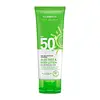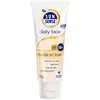What's inside
What's inside
 Key Ingredients
Key Ingredients

 Benefits
Benefits

No benefits
 Concerns
Concerns

 Ingredients Side-by-side
Ingredients Side-by-side

Water
Skin ConditioningDibutyl Adipate
EmollientEthylhexyl Salicylate
UV AbsorberEthylhexyl Triazone
UV AbsorberDiethylamino Hydroxybenzoyl Hexyl Benzoate
UV FilterPropylene Glycol
HumectantPotassium Cetyl Phosphate
EmulsifyingPhenylbenzimidazole Sulfonic Acid
UV AbsorberCetearyl Alcohol
EmollientBis-Ethylhexyloxyphenol Methoxyphenyl Triazine
Skin ConditioningSodium Polyacrylate
AbsorbentTriethanolamine
BufferingCellulose
AbsorbentPhenoxyethanol
PreservativePolyester-7
Skin ConditioningTitanium Dioxide
Cosmetic ColorantPoly C10-30 Alkyl Acrylate
Emulsion StabilisingParfum
MaskingNeopentyl Glycol Diheptanoate
EmollientCeteareth-20
CleansingPotassium Hydroxide
BufferingChlorphenesin
AntimicrobialXanthan Gum
EmulsifyingDisodium EDTA
Dimethicone
EmollientAluminum Hydroxide
EmollientAloe Barbadensis Leaf Juice
Skin ConditioningCocos Nucifera Oil
MaskingTocopheryl Acetate
AntioxidantIsomalt
HumectantStearic Acid
Cleansing1,2-Hexanediol
Skin ConditioningBiosaccharide Gum-4
Skin ConditioningMelanin
Skin ProtectingMalus Domestica Fruit Cell Culture Extract
Skin ConditioningPentylene Glycol
Skin ConditioningLecithin
EmollientVitis Vinifera Fruit Cell Extract
Skin ConditioningGlycerin
HumectantSodium Benzoate
MaskingEthylhexylglycerin
Skin ConditioningAlpha-Isomethyl Ionone
PerfumingCitronellol
PerfumingCoumarin
PerfumingGeraniol
PerfumingHexyl Cinnamal
PerfumingLimonene
PerfumingLinalool
PerfumingWater, Dibutyl Adipate, Ethylhexyl Salicylate, Ethylhexyl Triazone, Diethylamino Hydroxybenzoyl Hexyl Benzoate, Propylene Glycol, Potassium Cetyl Phosphate, Phenylbenzimidazole Sulfonic Acid, Cetearyl Alcohol, Bis-Ethylhexyloxyphenol Methoxyphenyl Triazine, Sodium Polyacrylate, Triethanolamine, Cellulose, Phenoxyethanol, Polyester-7, Titanium Dioxide, Poly C10-30 Alkyl Acrylate, Parfum, Neopentyl Glycol Diheptanoate, Ceteareth-20, Potassium Hydroxide, Chlorphenesin, Xanthan Gum, Disodium EDTA, Dimethicone, Aluminum Hydroxide, Aloe Barbadensis Leaf Juice, Cocos Nucifera Oil, Tocopheryl Acetate, Isomalt, Stearic Acid, 1,2-Hexanediol, Biosaccharide Gum-4, Melanin, Malus Domestica Fruit Cell Culture Extract, Pentylene Glycol, Lecithin, Vitis Vinifera Fruit Cell Extract, Glycerin, Sodium Benzoate, Ethylhexylglycerin, Alpha-Isomethyl Ionone, Citronellol, Coumarin, Geraniol, Hexyl Cinnamal, Limonene, Linalool
 Reviews
Reviews

Ingredients Explained
These ingredients are found in both products.
Ingredients higher up in an ingredient list are typically present in a larger amount.
Diethylamino Hydroxybenzoyl Hexyl Benzoate (DHHB) is a chemical UV-A absorber. It is formulated for high UVA protection (320-400 nm).
DHHB is well-liked for:
DHHB has been approved by the EU, Japan, Taiwan, and South America for use up to 10%. Unfortunately, it has not been approved for use in the US or Canada due to slow regulatory processes.
This ingredient is soluble in oils, fats, and lipids.
Learn more about Diethylamino Hydroxybenzoyl Hexyl BenzoatePhenoxyethanol is a preservative that has germicide, antimicrobial, and aromatic properties. Studies show that phenoxyethanol can prevent microbial growth. By itself, it has a scent that is similar to that of a rose.
It's often used in formulations along with Caprylyl Glycol to preserve the shelf life of products.
Titanium dioxide is a mineral UV filter widely used in sunscreens and cosmetics.
It is one of only two UV filters officially classified as “mineral” by regulatory agencies, the other being zinc oxide.
Titanium dioxide provides broad-spectrum protection mostly in the UVB and UVAII range, with some protection in the UVAI range.
While its UVA protection isn’t as strong as zinc oxide’s, the difference is minor.
A common myth is that mineral UV filters reflect UV light. However, modern research shows titanium dioxide absorbs UV radiation like chemical filters (~95% absorption & 5% reflection).
Thanks to its non-irritating nature, titanium dioxide is suitable for sensitive, acne-prone, or redness-prone skin. It is unlikely to cause "eye sting" like other sunscreen ingredients.
A major drawback of this ingredient is its white cast and thick texture. This is why mineral sunscreens often leave a white cast and are less cosmetically elegant than chemical/hybrid sunscreens.
To improve white cast and spreadability, micronized or nano-sized titanium dioxide is often used.
There are ongoing concerns surrounding nano-titanium oxide's impact on marine ecosystems.
There is no conclusive evidence that any form of titanium oxide (or any other sunscreen ingredients) will cause harm to marine ecosystems or coral reefs. The science is still developing but many consumers are keeping a close eye on this issue.
Please note, many destinations have reef-safety sunscreen rules. For instance, the U.S. Virgin Islands advises all visitors to use non-nano mineral sunscreens.
Nano mineral sunscreens once raised safety concerns about absorption into skin.
Extensive research has shown that they do not penetrate healthy or damaged skin; they remain safely on the surface and the top layer of dead skin (stratum corneum).
You'll likely find titanium dioxide bundled with alumina, silica, or dimethicone. These ingredients help make titanium dioxide highly photostable; this prevents it from interacting with other formula components under UV light.
Learn more about Titanium Dioxide